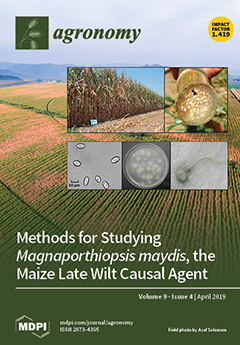To assess the effects of a new integrated nutrient management protocol on yield and cut stem quality, root morphology, N accumulation, nitrogen utilization efficiency (NUE), and P content in tissue, a biennial (2011 and 2012) chrysanthemum cut flower cultivation was carried out. In
[...] Read more.
To assess the effects of a new integrated nutrient management protocol on yield and cut stem quality, root morphology, N accumulation, nitrogen utilization efficiency (NUE), and P content in tissue, a biennial (2011 and 2012) chrysanthemum cut flower cultivation was carried out. In both years, two nutrition management (CNM: conventional NM and INM: integrated NM) treatments and two
Dendranthema grandiflorum (Ramat.) Kitamura cultivar (“White CV
1” and “Yellow CV
2”) treatments were compared. The treatments were arranged in a split-plot design with three replicates. CNM was fertilized using a recommended dose fertilization of mineral NPK; INM treatment was fertilized using a half dose (50%) of CNM plus a combined usage of N organic fertilizer, seaweed extract (
Ascophyllum nodosum), and microrganism consortium (
Glomus sp. and
Bacillus sp.). Yield at harvest (+19%), number of leaves (+33%), leaf area (+46%), number of flower heads (+27%), and total aboveground dry weight (+40%) were significantly increased by the INM application compared to the control. In terms of the root system, the increase was evident in terms of length (+174%), volume (+167%), projected area (+166%), and surface area (+165%), tips (+175%), forks (+285%), and crossings (+464%). The greatest N accumulation, in both years, was registered by INM treatment at harvest: +94% in 2011 and +55% in 2012. Differences in the NM were evident in the NUE, which was highest in CNM (on average 162) compared to INM (on average 142). In both years the P content in above-ground chrysanthemum tissues was in the order of head > leaves > stems, which was maintained in both INM and CNM treatments. A higher yield (138 stems m
−2) was obtained in “CV
2 Yellow” compared to “CV
1 White” (120 stems m
−2). Based on our findings, applying INM to chrysanthemum improves yield, cut flower quality, and plant nutrient uptake, in an agro–environmentally sustainable way. A basic economic analysis on fertilizers, cost gross production, and takings difference obtained, was carried out.
Full article





